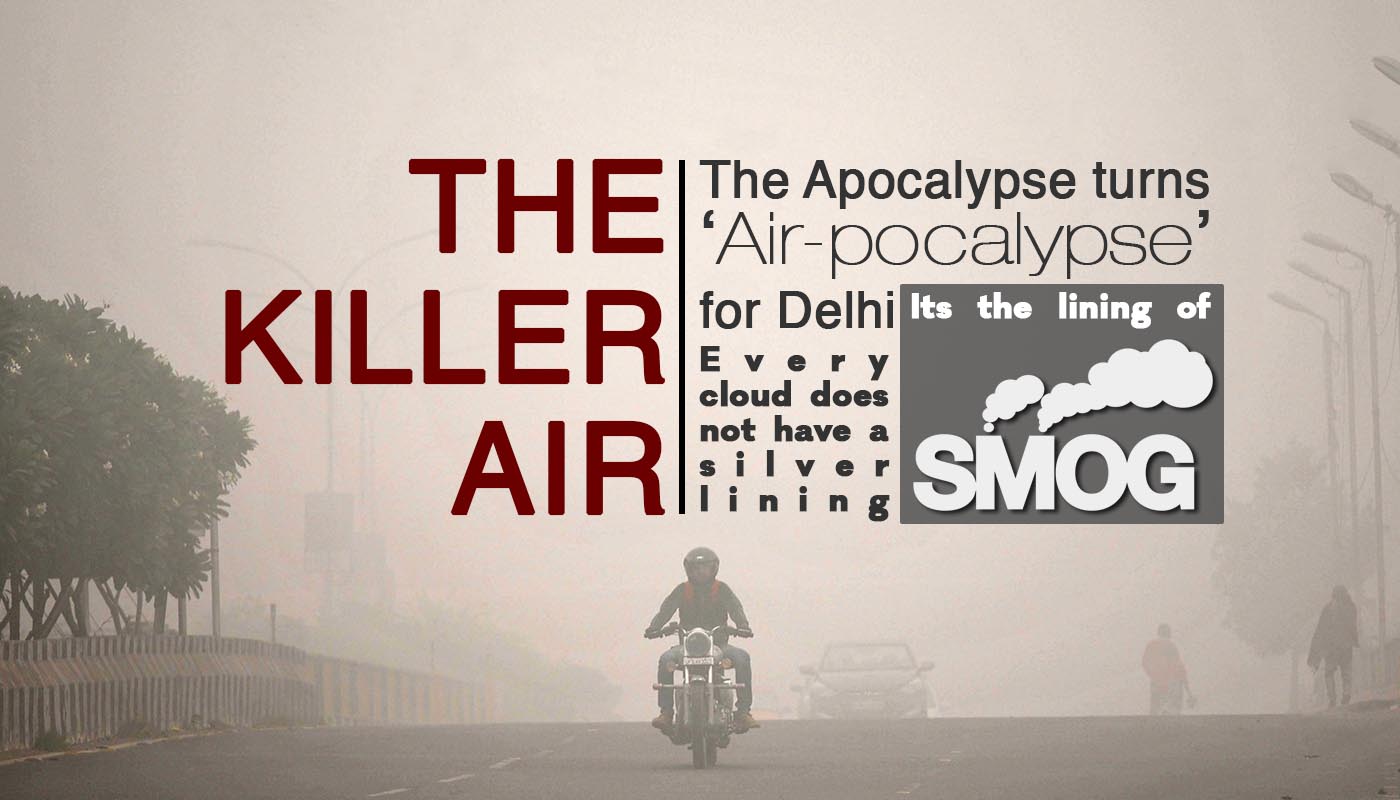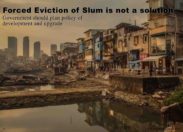The national capital of India Delhi is facing an emergency situation. It has been blanked by dense smog. A public health emergency has been declared by doctors in Delhi as the air quality in the world’s most populated capital city plunged to level linked to smoking at least 50 cigarettes in a single day. The Delhi chief minister, Arvind Kejriwal, called the city to be “Gas Chamber”, and had asked residents to avoid leaving their homes as smog enveloped streets and landmarks of Delhi. Also the Primary schools in Delhi were kept shut for a few days. The city has recorded level of PM 2.5 i.e. particulate matter with a diameter of 2.5 microns or less, prolonged exposure to which causes respiratory diseases 430 times the US standards.
Particulate pollution comes from many sources like vehicles, industrial plants, biomass burns and dust generated by construction or traffic on poorly asphalted roads. Reducing smog and improving air quality in Indian cities over the long term requires an approach that targets each source of pollution.
Smog is a type of air pollutant. The word “Smog” was coined in the earlier 20th century as a portmanteau of the words smoke and fog to refer to smoky fog, its opacity and odor. Delhi is the most polluted city in the world and according to one estimate; air pollution causes the death of about 10,500 people in Delhi every year. During 2013-14, peak level of fine particulate matter (PM) in Delhi increased by about 44% primarily due to high vehicular and industrial emission, construction work and crop burning in adjoining states. Rising air pollution level has significantly increased lung related ailments (especially asthma and lung cancer) among Delhi’s children and women. The government of Delhi has declared a health advisory as the people of Delhi are facing the following health issues like breathlessness, chest constriction, irritation in eyes, asthma and allergy.
Air pollution in November 2017 in the national Capital Territory of India peaked on both PM2.5 and PM10 levels. It has been reported as one of the worst levels of air quality in Delhi since 1999. Low visibility has resulted in accidents across the city, notably a 24 vehicle pile-up on the Yamuna Expressway. Looking at the situation of Delhi then, the Chief Minister of Delhi, Arvind Kejriwal, came out with the following proposed action items to attempt to reduce the air pollution. Though the proposed disaster management proposal was just to overcome the situation on a temporary bases but it was the need of the hour:
His plan of action stated, in verbatim:
1) All Delhi School will remain shut for the certain period of 3 days.
2) No construction and Demolition work will take place for five days in Delhi.
3) People were advised to stay indoor specially the elderly once, children and pregnant ladies.
4) All diesel generators set have been banned for ten days, except at hospitals and in emergencies.
5) The coal- based Badarpur power plant was shut for a period of 10 days. Ban on fly ash transportation from the power plants are some of the steps taken by the government of Delhi.
On November 25, 2016 the Supreme Court of India banned the sale of firecrackers in Delhi to alleviate pollution. This showed a downfall in the level of emission from firework by 40% during Diwali season in 2017 as compared to 2016, though there was a high usage of firecrackers in 2017. This is because winter pollution levels are affected by several other factors which vary from one year to the next, including paddy stubbles burning in the Indo-Gangetic plains, use of diesel for pollutants. The high pollution despite the ban also showed that other pollution sources, such as vehicular emission have been neglected by the government.
Since the beginning of November 2017, average pollution levels in the city have exceeded 10 times the World Health Organization. But pollution is not just a Delhi problem Indian cities are constantly ranked among Asia’s most polluted according to WHO. As per the WHO 2016 database, 10 of the world’s most polluted cities, in term of fine particulate matter are in India and include cities like Allahabad, Ludhiana, Delhi, Gwalior, Kanpur, etc.
Air pollution in India is quite a serious issue with the major sources being fuel wood and biomass burning, fuel adulteration vehicle emission and traffic congestion. The Air (Prevention and Control of Pollution) Act was passed in 1981 to regulate air pollution and there have been some measurable improvements. However, the 2016 Environmental Performance Index ranked India 141 out of 180 countries. In 2015, Government of India, together with IIT Kanpur launched the National Air Quality Index.Let us first evaluate the causes:
1) Fuel wood and biomass burning is the primary reason for near permanent haze and smoke observed above rural and urban India, Cooking fuel in rural India is prepared from a wet mix of dried grass, fuel wood pieces, hay, leaves and mostly cow/livestock dung. When it is burned, it produces smoke and numerous indoor air pollutants at concentration 5 times higher than coal. Survey suggest over 100 million household in India use stave (chullahs) using biomass cakes, fuel wood and trash as cooking fuel.
2) Traffic gridlock in Delhi and other Indian cities is extreme. Motor Vehicle emissions are one of the causes of poor air quality in Delhi. According to some reports, 80 % of PM2.5 air pollution is caused by vehicular traffic, slow speeds and idling vehicles produce, per trip, 4-8 times more pollutants and consume more carbon footprint flues, than free flowing traffic.
3) Some Indian taxis and auto- rickshaws run or adulterated fuel blends. Adulteration of gasoline and diesel with lower priced fuels is common in South Asia, including India. As fuel prices rise, the public transport driver cuts cost by blending the cheaper hydrocarbon into highly taxed hydrocarbon. The blending may be as much as 20-30%. For a low wage driver the adulteration can yield short term savings that are significant over the month. The consequences of long term air pollution quality of life and effect on health are simply ignored. Apart from all this, the exhaust from diesel generators is also a major cause of pollution in metro city like Delhi.
4) Dust from construction sites, and burning garbage and illegal industrial activities in Delhi.
5) The Badarpur Thermal Power Station, a coal fired power plant built in 1973, another major source of air pollution in Delhi. Despite producing less than 8% of the city’s electrical power, it produces 80 to 90% of the particulate matter pollution from the electric power sector in Delhi. During the Great Smog of Delhi in November 2016, the Badarpur Power Plant was temporarily shut down to alleviate the acute air pollution, but was allowed to restart on February 1, 2017. Looking at the condition of Delhi in November 2017, the Badarpur Thermal Power Station was kept shut for 10 days.
6) The crop burning in Haryana and Punjab is being blamed as the primary reason for this sudden toxic smog enveloping the city and its neighboring areas. The belt produces an estimated 34 million tons (mt) of paddy straw very season, of which some 23 mt is practically useless and is burned within less than a month span between mid October and around November. The reason for burning them is that disposal of this residue isn’t easy.
Lack of electricity is also the reason why the farmers have to set their farms on fire. If there was sufficient electricity supply in these areas there will be more availability of water with which the farmers can turn these residues into compost fertilizers. The viable technological remedy to this problem can be the use of Turbo Hardy Seeder (THS). This is a tractor- mounted machine that basically cuts and lifts the standing stubble, drills the wheat seed into the bare soil. The THS not only dispenses with the need for burning residue, but actually allow wheat to be planted even on field containing straw.
7) Lack of political priority is the major reason apart from all the other reason for air pollution in Delhi. Shifting the blame to the Central Government for ignoring its suggestion of sprinkling of water from choppers to fight pollution, the Delhi government called the situation to be a Gas chamber.
Like Beijing which is one of the worlds’s most polluted cities have invented a tower like structure which sucks in Beijing’s smog and turns it into diamonds. This largest smog vacuum cleaner sucks up 30,000 cubic meter per hour cleans it on a nano level using very little electricity and then releases the clean air. Since most of the China Smog comprises of Carbon which under high pressure can be converted into diamonds. So the technicians compress it to convert this smog to diamonds. Measures like this are needed on a technical sided in India to fight the present situation.
For Corporate this is the right time to respond, through these series, corporate have the opportunity to present good CSR causes and social opportunities. These steps taken for their employees can prove a great initiative by the corporate amid Smog Airpocalypse. Csr to curb the pollution kill may include:
1) Distribution of Anti-Pollution Masks (of standard quality) to all of their employees on a regular interval till air pollution level minimizes.
2) Allow employees to work from home or call employees on roster basis, making most of the shifts in non peak hours.
3) Organizations can provide/arrange cabs or shuttle services as much as they can to their employees, this will make employees avoid use of their private vehicles to work also will help reduce traffic.
4) Installing air purity on every floor. Instead planting indoor plants like Areca Palm Tree or Snake Plant, etc which not only absorb pollutants from air but also release Oxygen continuously even in nights.
5) Also planting more and more of saplings in their open areas to supplement fresh air at least for their premises.
Like in Philips, the CSR has organized free COPD (Chronic Obstructive Pulmonary Disease) test camps across 4 cities Kanpur, Delhi/NCR, Chandigarh & Bangalore to help people identify and fight the growing lung problems.
Companies can coordinate with NGOs and government agencies for finding innovative and less polluting means to dispose agricultural waste and encourage good practices amongst farmers in these areas, while simultaneously assisting and reporting illegal agriculture produce burning by farmers to authorities for ensuring compliance.
Companies can combine efforts with NGOs, to coordinate with security agencies and resident housing societies to train and ensure that security personnel working at night shifts, don’t burn plastic materials, tyres, woods and paper waste and other combustible items during winter months to keep themselves warm.
In ensuring CSR spending legitimacy for above causes, ofcourse companies have to first ensure that the same is within the framework of their respective CSR policy and that it is carried out as a full fledged project and not as one time donation.
jnicsr #jnicsrtimes #nikhilkumarsarojaz







Leave a Reply